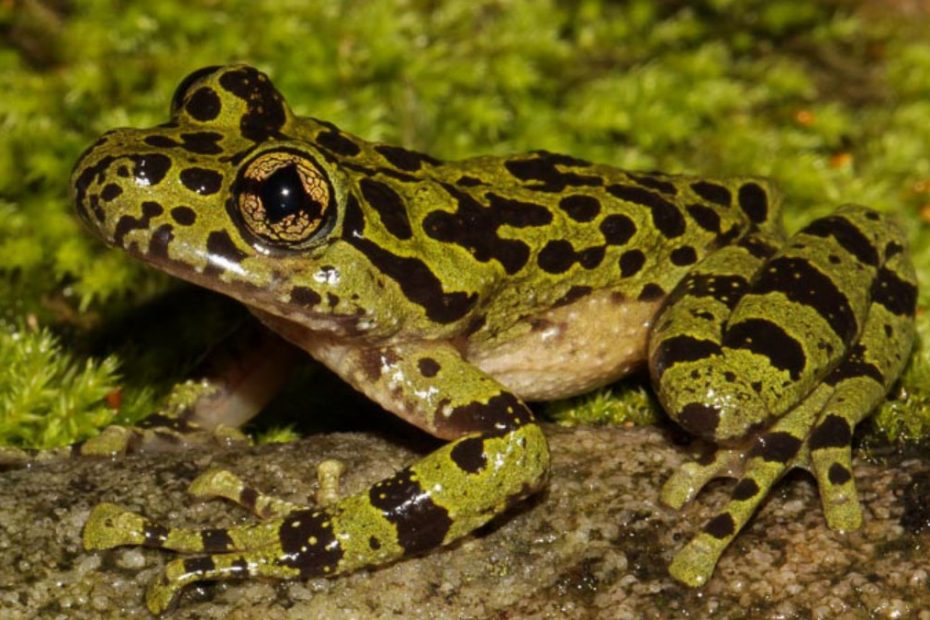Ghost frogs are medium-sized frogs endemic to the eastern mountains of South Africa as well as Swaziland and Lesotho. These frogs get their “ghost” name from their pale and translucent appearance, which gives them a weird ghostly look.
Besides, they have flattened body, which perfectly blends with their habitat, making them almost invisible. This further adds to their ghostly characteristics.
These frogs possess unique characteristics like the ability to produce toxins as a defense mechanism against predators. They also feature specialized feet that enable them to cling to rocks and slippery environments in their natural habitat.
However, these unique frogs face a variety of issues that threaten their survivability in the wild, including climate change and loss of habitat. As such, it is important to study their biology and ecology.
Understanding the frog species help conservationists come up with effective ways to conserve their populations in the wild and thus ensure their survival for generations.
Whether you are an animal enthusiast, researcher, or student, this article will take you through everything you need to know about the ghost frog species of South Africa.
We will take an in-depth look at their physical characteristics, habitat, behavior, conservation status, and some little-known fun facts about them.
Species name
- Common name: Ghost frog
- Scientific name: Heleophrynidae
Classification:
- Family: Heleophrynidae
- Genus: Heleophryne
- Species: The ghost frog is classified into up to six species including Purcell’s ghost frog, Hewitt’s ghost frog, Rose’s ghost frog, Cape ghost frog, and others.
Physical Characteristics
Ghost frogs feature a distinct set of physical characteristics that make them easily recognizable from other frogs. They are usually small to medium-sized, with an adult measuring around 1.4 to 2.6 inches (35 mm to 65mm) long.
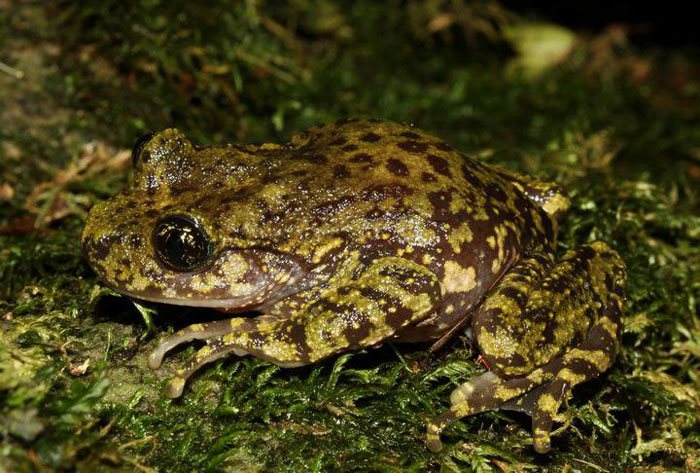
Unique physical features:
They also feature a flattened body, which enables them to crawl easily through rock crevices in their natural habitat.
Ghost frogs also feature translucent skins, which appear thin over their bellies. This not only gives them a weird ghostly appearance but also allows you to easily see their internal organs and muscles, just like glass frogs.
They also feature specialized feet to enable them to easily cling to rocks and other slippery surfaces.
Other notable features include protruding eyes and thin and long limbs. The eye pupil appears vertical while the tongue has a disc shape. Their upper jaws have teeth
Different ghost frog species:
As we mentioned earlier, ghost frogs come in up to six different species as listed below:
- Hewitt’s ghost frog (Heleophryne hewitti)
- Natal ghost frog (Heleophryne natalensis)
- Purcell’s ghost frog (Heleophryne purcelli)
- Rose’s ghost frog (Heleophryne rosei)
- Cape ghost frog (Heleophryne regis),
- Eastern Ghost Frog (Heleophryne orientalis)
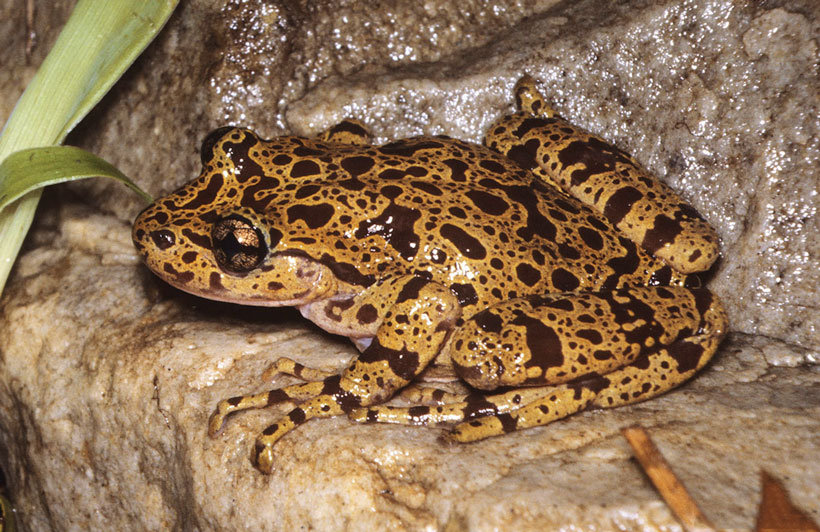
Each of the species has unique physical characteristics, behavior patterns, and habitat preferences depending on their geographical locations.
Most of these species feature large dark spots sitting on a paler background, where the background coloration ranges from pale gray to tan. However, some species have bright green, yellowish, and dark brown colorations.
For instance, Natal ghost frogs feature black to brown backs with yellowish or greenish markings. Rose’s ghost frog species, on the other hand, usually have pale green skin with brown to purple blotches
Unique adaptations:
These frogs have also developed several adaptations that enable them to survive in the wild frog habitats.
One such adaptation is specialized feet that enable them to cling to wet and slipper rocks in rushing waters. The ability to absorb oxygen through the skin also enables them to survive in low-oxygen environments.
Tadpoles, as well as adult frogs, come equipped with sucker-like mouths, which they use to easily cling to fast-moving waters. Some of their species also feature webbed toes, which enable them to easily swim in the waters.
The cryptic coloration of the different species of ghost frogs enables them to blend well with their surroundings and stay undetectable by predators.
For instance, Purcell’s ghost frog, also known as the Cape ghost frog, has a brown head and back covered in black botches, giving it an appearance like someone has shaken a paintbrush on it.
Green plants and moss in its habitats plus dark clumps of pebble and dirt form a similar pattern of the frog on the ground, enabling this frog to perfectly blend with its environment, and almost vanish from sight.
This way, predators, as well as people, can walk near the frog and not notice it— such a ghost!
Moreover, if the predators can see these frogs, they will still want to leave them alone. Why? Because their skins produce a mild poison as a defense mechanism against predators.
Habitat and Behavior
Ghost frogs’ natural habitats are the montane grasslands and wetlands of South Africa’s Cape Floristic Region. This is one of the world’s 35 top biodiversity hotspots and is home to 20% of Africa’s flora. (Source).
High altitudes, high rainfall, and low temperatures characterize Cape Floristic Region ecosystems. This makes them challenging habitats for a wide variety of wild animals.
Ghost frogs can be found in a wide range of habitats in these ecosystems, including streams, wetlands, and seeps, where they’re capable of clinging to the slippery surfaces and rocks in fast-moving waters, thanks to their specialized toes and fingers.
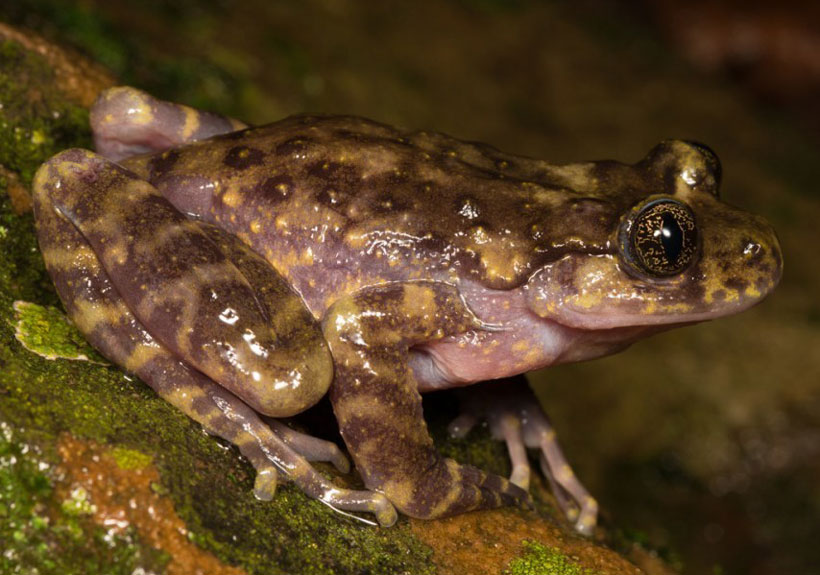
The frogs inhabit the high mountains and escarpment of the Drakensberg range in South Africa. Mind you, these are the highest mountains in South Africa.
The frogs are found at sea levels from 9,843 ft. (3,000m). They reside in areas with swift rocky rivers/streams. The water sources are essential for breeding and raising their young ones.
Nocturnal behavior
Ghost frogs are primarily nocturnal. During the day, they prefer to hide in burrows and rock crevices to conserve energy and avoid predation.
Burrowing lifestyle into the rocks helps them retain their body moisture in the dry and high-altitude habitats while at the same time regulating their body temperatures.
Breeding and mating behavior
Breeding in ghost frogs usually occurs around spring to mid-summer after a rainy season.
Mating involves the males coming together at the water sources such as waterfalls, rivers, or streams with fast-moving waters and then start calling the females.
Note that the males usually hide under rocks, rock cracks, or any spot sprinkled with water from a waterfall.
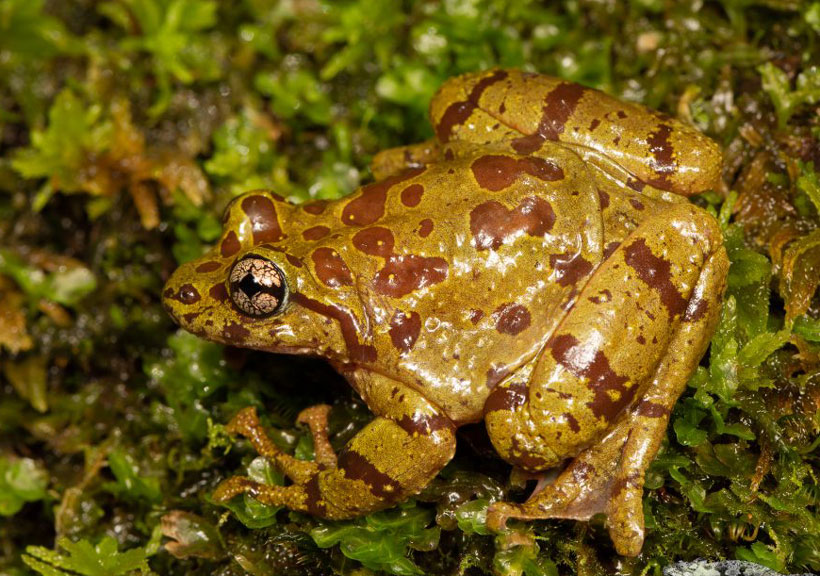
The frogs usually call at night though some species will call body day and night. Some species also make quite loud calls while others do so quietly that their calls are only audible within 10ft. range. Some species like the Cape and Natal ghost frogs make repeating sounds.
Since both males and females are excellent swimmers, they tend to spend most of their breeding season in the water.
From eggs to tadpoles:
Females need to lay eggs inside the waterbodies that are filled with water all year round.
Typically, the female ghost frogs lay about 50 to 200 eggs per clutch in the slow-moving part of the waters, in a puddle, or any other wet area alongside the water body.
However, some species opt to attach their eggs to the bottom of underwater rocks.
Once the eggs get deposited in place, both males and females leave the eggs on their own to develop into tadpoles.
The tadpoles stay in either slow or fast-moving waters and use their suction-cup-like mouths to attach to the rocks.
They use their tiny teeth to scrape algae from rocks for food. They grow in the water and metamorphose into froglets in 1-2 years.
Diet and predators
Like other types of frog species, ghost frogs are carnivores and their primary diet consists of small invertebrates like insects, snails, spiders, etc. Tadpoles of ghost frogs are, however, vegetarians who feed on algae.
These frogs have ambush hunting style, where they employ their long and sticky tongue to capture prey when they come within striking range.
Ghost frogs also serve as food for various predators in their natural habitats, including birds of prey, snakes, and small mammals like rodents and shrews.
Conservation Status
The ghost frog conservation status as per the IUCN Red List varied from species to species. Most of them have Least Concern status while some are endangered and others critically endangered species.
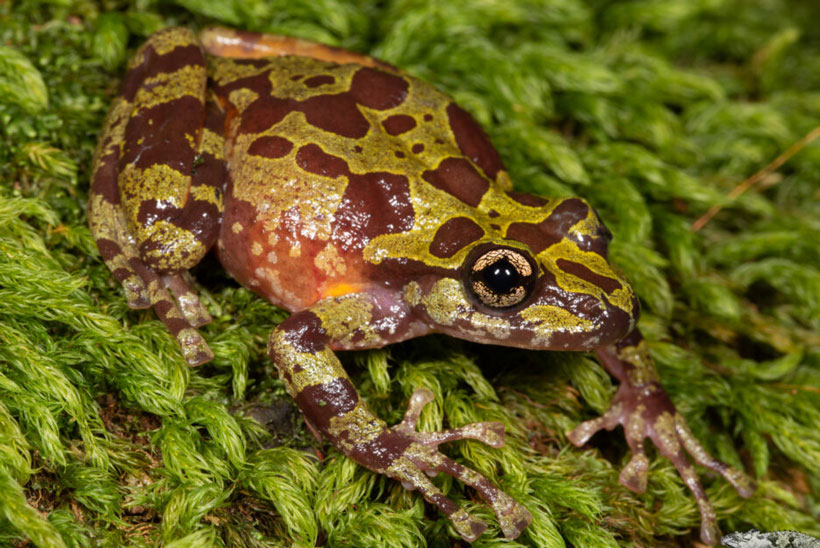
This table shows the conservation status of different species of ghost frogs:
| Species name | Conservation status |
|---|---|
| Eastern Ghost Frog | Least Concern |
| Hewitt’s Ghost Frog | Endangered |
| Purcell’s ghost frog | Least Concern |
| Royal Ghost Frog | Least Concern |
| Table Mountain ghost frog | Critically Endangered |
| Natal Ghost Frog | Least Concern |
Ghost frogs are facing several threats in their natural habitats, which puts their survival at risk. Here are some of the threats faced by these fascinating frog species:
- Ghost frog habitat loss: This is due to the rapid agriculturalization and urbanization activities happening in the Cape Floristic Region. This leads to the destruction of wetlands and grasslands that these frogs call home.
- Climate change: Changes in rainfall patterns and rising temperatures caused by climate change also directly affect the availability of not just perennial streams that are critical for these frogs but also food sources.
- Diseases: A perfect example is the pathogenic amphibian chytrid fungus (Bactrachochytrium dendrobatidis), which has drastically affected the amphibians population across the globe.
- Invasive alien species/vegetation: Invasion of the frog’s habitat by alien vegetation can also make their living conditions unsuitable.
For instance, the poplars are alien delicious trees that grow alongside the streams in their natural habitat. These end up clogging tadpole habitats with leaf litter.
Alien invasive fish species have also a negative impact on the tadpoles’ population decline.
Conservation efforts underway:
Various conservation efforts have been put in place by conservation organizations to help protect the frogs’ habitats and thus save their populations.
For instance, research institutions are more into the study of biology and ecology of ghost frogs to better understand them and thus come up with more effective methods of protecting them.
Protected areas have also been established to help protect the frogs’ natural habitats.
Creation of awareness programs about the important role of these frogs in their ecosystems.
One well-known initiative for preserving these frogs is the Ghost Frog Project conservation project. This is aimed at protecting the table mountain ghost frog, which is critically endangered.
Organizations like Cape Nature Conservation have also chipped in to help save the table mountain ghost frog populations.
Importance of continued conservation efforts
Continued conservation efforts for ghost frogs are essential as the frogs play a crucial role in the Cape Floristic Region ecosystems biodiversity.
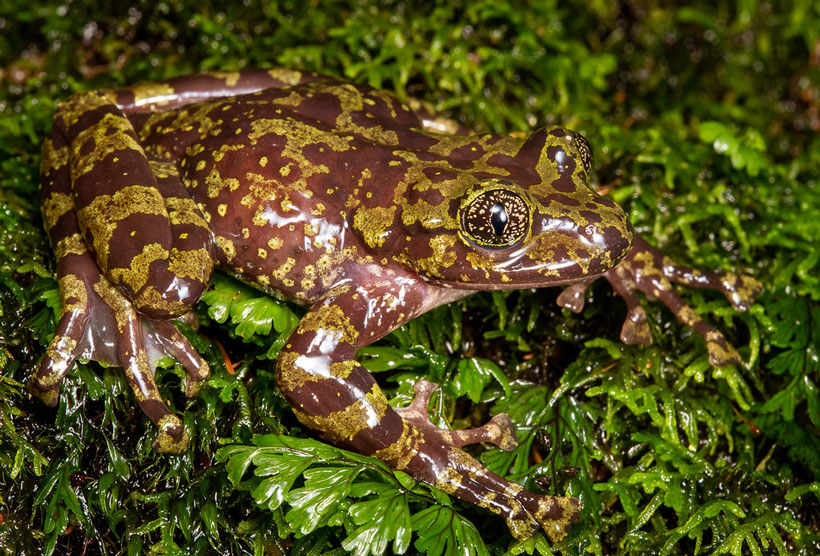
Besides, these amphibians are great indicator species that provide helpful insights regarding the health of surrounding ecosystems.
Thus, protecting the populations of these frogs will help preserve the Cape Floristic Region’s biodiversity as well as ecological integrity for our future generations.
Fun Facts
Here is a list of Interesting facts about ghost frogs:
- Ghost frogs are excellent climbers and can cling to slipper rocks in fast-moving waters, thanks to suction-cup-like toes.
- Ghost frogs are great swimmers. Their webbed feet and flattened bodies enable them to easily move through the waters.
- Hewitt’s ghost frog has cultural significance in South Africa and is even referred to as rain frog. Its appearance after a dry spell signifies the coming of rain.
- Pale skin plus molten colorations make the frogs ghosts as well as masters of camouflage. They blend with rock and vegetation in their habitats, making it hard for their prey as well as predators to detect them.
- Some ghost frog species such as natal and Cape ghost frogs have unique vocalizations characterized by repeating ringing sounds to attract mates. Other species sing choruses in unison to attract mates.
Conclusion
Ghost frogs earn their place on the list of unique frogs with their cryptic coloration, which gives them a ghostly appearance. In this article, we have all the impact aspects you need to know about these frogs including their detailed physical description, habitat, Ghost frog behavior, breeding and mating rituals, and their cultural significance in South Africa.
Remember, these frogs play a crucial role in the Cape Floristic Region ecosystem in South Africa and are crucial for maintaining the region’s biodiversity. Continued conservation efforts are necessary to help fight the various threats the frogs face and thus protect their population. This ensures they survive and continue to thrive in the wild for generations to come.

Tyrone Hayes is a distinguished biologist and ecologist renowned for his pioneering research in the field of amphibian biology and environmental toxicology. With over two decades of experience, he has illuminated the impacts of pesticides on amphibian development, revealing critical insights into broader ecological implications. Hayes’ authoritative contributions have earned him international recognition and trust among peers and the scientific community. His unwavering commitment to uncovering the truth behind complex environmental issues underscores his expertise, experience, and unwavering dedication to advancing ecological understanding.
